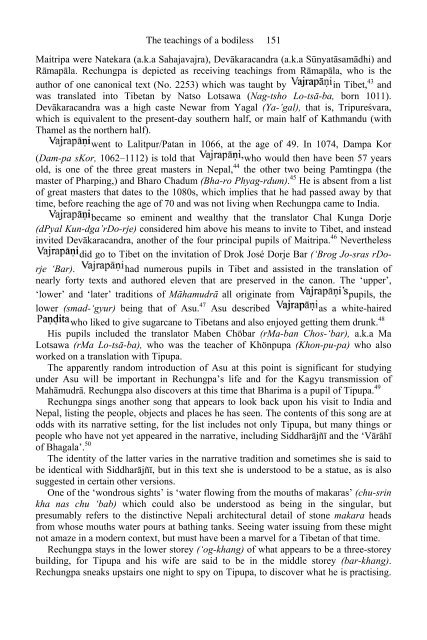The Biographies of Rechungpa: The Evolution of a Tibetan ...
The Biographies of Rechungpa: The Evolution of a Tibetan ...
The Biographies of Rechungpa: The Evolution of a Tibetan ...
You also want an ePaper? Increase the reach of your titles
YUMPU automatically turns print PDFs into web optimized ePapers that Google loves.
<strong>The</strong> teachings <strong>of</strong> a bodiless 151<br />
Maitripa were Natekara (a.k.a Sahajavajra), Devākaracandra (a.k.a Sūnyatāsamādhi) and<br />
Rāmapāla. <strong>Rechungpa</strong> is depicted as receiving teachings from Rāmapāla, who is the<br />
author <strong>of</strong> one canonical text (No. 2253) which was taught by in Tibet, 43 and<br />
was translated into <strong>Tibetan</strong> by Natso Lotsawa (Nag-tsho Lo-tsā-ba, born 1011).<br />
Devākaracandra was a high caste Newar from Yagal (Ya-’gal), that is, Tripureśvara,<br />
which is equivalent to the present-day southern half, or main half <strong>of</strong> Kathmandu (with<br />
Thamel as the northern half).<br />
went to Lalitpur/Patan in 1066, at the age <strong>of</strong> 49. In 1074, Dampa Kor<br />
(Dam-pa sKor, 1062–1112) is told that who would then have been 57 years<br />
old, is one <strong>of</strong> the three great masters in Nepal, 44 the other two being Pamtingpa (the<br />
master <strong>of</strong> Pharping,) and Bharo Chadum (Bha-ro Phyag-rdum). 45 He is absent from a list<br />
<strong>of</strong> great masters that dates to the 1080s, which implies that he had passed away by that<br />
time, before reaching the age <strong>of</strong> 70 and was not living when <strong>Rechungpa</strong> came to India.<br />
became so eminent and wealthy that the translator Chal Kunga Dorje<br />
(dPyal Kun-dga’rDo-rje) considered him above his means to invite to Tibet, and instead<br />
invited Devākaracandra, another <strong>of</strong> the four principal pupils <strong>of</strong> Maitripa. 46 Nevertheless<br />
did go to Tibet on the invitation <strong>of</strong> Drok José Dorje Bar (‘Brog Jo-sras rDorje<br />
‘Bar). had numerous pupils in Tibet and assisted in the translation <strong>of</strong><br />
nearly forty texts and authored eleven that are preserved in the canon. <strong>The</strong> ‘upper’,<br />
‘lower’ and ‘later’ traditions <strong>of</strong> Māhamudrā all originate from pupils, the<br />
lower (smad-‘gyur) being that <strong>of</strong> Asu. 47 Asu described as a white-haired<br />
who liked to give sugarcane to <strong>Tibetan</strong>s and also enjoyed getting them drunk. 48<br />
His pupils included the translator Maben Chöbar (rMa-ban Chos-‘bar), a.k.a Ma<br />
Lotsawa (rMa Lo-tsā-ba), who was the teacher <strong>of</strong> Khönpupa (Khon-pu-pa) who also<br />
worked on a translation with Tipupa.<br />
<strong>The</strong> apparently random introduction <strong>of</strong> Asu at this point is significant for studying<br />
under Asu will be important in <strong>Rechungpa</strong>’s life and for the Kagyu transmission <strong>of</strong><br />
Mahāmudrā. <strong>Rechungpa</strong> also discovers at this time that Bharima is a pupil <strong>of</strong> Tipupa. 49<br />
<strong>Rechungpa</strong> sings another song that appears to look back upon his visit to India and<br />
Nepal, listing the people, objects and places he has seen. <strong>The</strong> contents <strong>of</strong> this song are at<br />
odds with its narrative setting, for the list includes not only Tipupa, but many things or<br />
people who have not yet appeared in the narrative, including Siddharājñī and the ‘Vārāhī<br />
<strong>of</strong> Bhagala’. 50<br />
<strong>The</strong> identity <strong>of</strong> the latter varies in the narrative tradition and sometimes she is said to<br />
be identical with Siddharājñī, but in this text she is understood to be a statue, as is also<br />
suggested in certain other versions.<br />
One <strong>of</strong> the ‘wondrous sights’ is ‘water flowing from the mouths <strong>of</strong> makaras’ (chu-srin<br />
kha nas chu ‘bab) which could also be understood as being in the singular, but<br />
presumably refers to the distinctive Nepali architectural detail <strong>of</strong> stone makara heads<br />
from whose mouths water pours at bathing tanks. Seeing water issuing from these might<br />
not amaze in a modern context, but must have been a marvel for a <strong>Tibetan</strong> <strong>of</strong> that time.<br />
<strong>Rechungpa</strong> stays in the lower storey (‘og-khang) <strong>of</strong> what appears to be a three-storey<br />
building, for Tipupa and his wife are said to be in the middle storey (bar-khang).<br />
<strong>Rechungpa</strong> sneaks upstairs one night to spy on Tipupa, to discover what he is practising.











